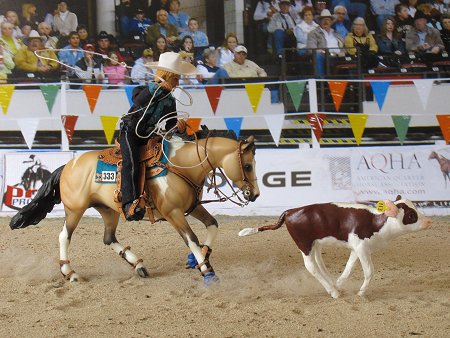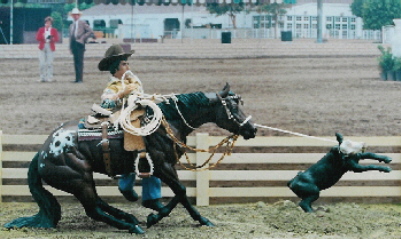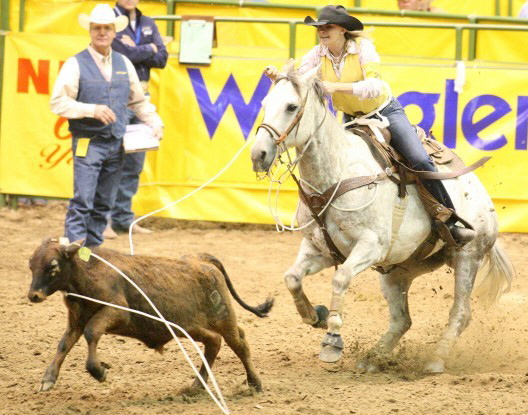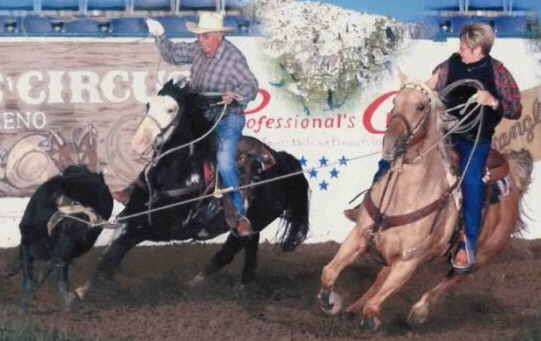IMEHA (International Model Equine Hobbyists Association) was an online photo showing site that existing until 2018. Included on the site were these guidebooks for judging and showing model horses in Performance classes. MEPSA has obtained permission to share the info contained in the guides.
Calf Roping :: Breakaway Roping :: Dally Team Roping :: Extra Credit :: Tack :: Rider :: Set-Up Options :: Photo Examples
The purpose of any roping class is to provide an opportunity for the horse to demonstrate and be judged on its natural talent and ability, its willingness to perform, and the level of training that makes it suitable for competitive timed roping events outside the show horse arena. The rope horse will be evaluated through a series of individually judged maneuvers that when combined result in a score that most accurately exemplifies that rope horse’s ability to allow its rider to catch and handle a calf and/or steer most efficiently and effectively.
General Rules For All Roping Events:
(a) Horses must start from the roping box.
(b) Calf roping and heading horses only (whether being judged or not) in dally team roping must start from behind a barrier (an electronic barrier is acceptable).
(c) Only the horse’s performance, including manners behind the barrier and at all other times, is to be judged.
(d) The contestant shall not attempt to rope the animal until the barrier flag has been dropped. Any attempt by a contestant to position his horse behind the barrier enabling the contestant to rope the animal without attempting to leave the box shall be disqualified.
(e) Breaking the barrier, or any unnecessary whipping, jerking reins, talking or any noise making, slapping, jerking rope or any unnecessary action to induce the horse to perform better, will be considered a fault and scored accordingly.
(f) The judge may at his discretion award new cattle to enable contestant to show his horse’s ability on the cow including:
(1) The cow won’t run or stops
(2) Chute or barrier malfunctions
(3) Cow turns back immediately
(4) Cow leaves arena
(g) Participation in jackpots paid on time in roping events must be at the contestant’s option.
(h) In all roping events a run must be completed within a one minute time limit.
Calf Roping:
A timed event in both breed shows and rodeos. The roper is placed in a roping box with a calf in a chute beside the roper. There is an elastic cord or barrier used in front of the box. When the calf is released the horse begins to run. If the horse breaks the barrier before time a penalty of 5 seconds is added to the score. Once the horse and calf are running; the rider ropes the calf around the neck, dismounts the horse, and runs down the rope to the calf. The horse holds the calf by pulling against the rope. The rider picks up the calf and throws it and then ties any of three feet together with a piggin string (usually carried in the rider’s mouth or belt loop until used.) Time is stopped when rider signals that the calf is tied, usually by waving his hands. Once the calf is tied, the rider remounts horse and walks horse forward a few steps to give slack to the rope. The calf must stay down and tied for 6 seconds. In rodeos this event is only timed. In show arena the horse’s performance is judged including manners in the box, speed to calf, rating, stopping, working the rope and manners while rider returns after roping calf. Calf should be less than 6 months with no horns so smaller calves should be used.
Tack Differences Than From Listed:
Roping reins are used. A tie down and rear cinch is a must. Mechincal hackamore may be used in rodeos but not arena shows. Hackamore bosal are often seen. A Neck Foul Rope is required, it keeps the rope from being tangled and keeps the calf from running out to the right. A neck rope is tied around the crest of the neck. The end of the lariat in fed through the neck rope. The foul rope by consist of a rope loop around the neck or may be attached back to the saddle horn or go through the underneath of the gullet and back up to saddle horn and tied off.
Look for:
A taunt line between horse and calf if already roped.
Head of calf should be pointed toward the horse to illustrate how the horse worked the rope.
Horse needs to be watching the calf so eyes of horse needs to be in line with calf’s head.
Most rider’s throw from the right and dismount from the right. If not comment line needs to address a left handled roper.
If the horse is moving and rope was settled around the calf’s neck the horse should be stopping and rider should be beginning to dismount.
Rider should have a piggin string in his mouth ready to tied off calf.
Foul Neck Ropes may be any color of braided rope
Judge Calf Roping On These Rulings:
(a) The roper may throw only two loops and must be done so within a one-minute time limit from the time the calf leaves the chute.
(b) In open competition, if more than one loop is thrown, the roper must carry a second rope tied to the saddle, and this rope must be used for the second loop.
(c) Youth or amateurs who desire to throw the second loop, may recoil rope or use a second rope tied to saddle.
(d) If the roper fails to catch, he will retire from the arena with no score.
(e) Any catch that holds is legal, but rope must remain on calf until tie is completed and roper has mounted horse.
(f) If calf is not standing when roper reaches calf, the roper must re-throw calf by hand, crossing any three feet, and tie with not less than one complete wrap and a half hitch.
(g) Rope must be run through a foul rope around the horse’s neck, and may, at the discretion of the rider, be run through a “keeper”. If a keeper is used, it must be attached to the noseband of the tie-down but never in front of the head stall and cannot be attached to the bridle or bit.
(h) Only the roper may touch the calf while the horse is being judged. Roper may dismount from either side and leg or flank calf.
(i) Scoring will be on the basis of 0-100, with 70 denoting an average performance. Each maneuver will be scored from a plus three to a minus three, in 1/2 point increments.
(j) The tie-down roping horse will be judged on four different maneuvers:
(1) box and barrier
(2) running and rating
(3) stop
(4) working the rope
The following deductions will result:
One (1) Point:
•dragging the calf while being tied, deduct one point for each three feet moved up to 12 feet.
Two (2) Point:
•freeze-up in the box (refusing to move)
•jumping the barrier
•setting up or scotching
•rubbing the rope
•failure to continue backing while roper is flanking the calf
•slack in the rope
Three (3)Point:
•a two-loop run
Five (5) Point:
•refusing to enter the box
•rearing in the box
•breaking the barrier
•running into the calf
•dragging the calf, after the calf is tied, from six to 12 feet (special consideration should be given for excessive movement of the calf after the calf is tied)
•horse walking up the rope (rope on ground)
•blatant disobedience including kicking, biting, bucking, rearing and striking
Breakaway Roping:
Breakaway Roping is available only in the amateur and youth divisions, this is a timed event with a one-minute time limit. Contestants enter the barrier and the calf breaks. Contestant ropes the calf while the rope is not run through any neck foul rope or tied off to saddle horn. Once a catch is made the animal runs free with rope dragging behind it.
1) Horse must start from behind a barrier. Calves must be used.
2) Two loops will be permitted. One or two ropes are to be tied to the saddle horn by a heavy string, in such a manner as to allow the rope to be released from the horn when the calf reaches the end of the rope. A visible cloth or flag must be attached to the end of the rope tied to the horn to make it easier for the flagger to see it break free.
3) The contestant shall receive no time should he break the rope from the horn by hand or touch the rope or string after the catch is made. If the rope dallies or will not break free when the calf reaches the end of it, the contestant will receive no time.
4) Rope may not pass through bridle, tie-down, neck rope or any other device.
5) It is recommended, whenever possible, the judge be on horseback and flag the class.
Dally Team Roping – Heading and Heeling:
A western event in which both rodeos and arena shows hold. The ropers begin the event from two roping boxes with the steer or cow to be roped in a chute between them. The header is on the left and the heeler on the right. When the steer is released it is given a two second head start. Then the barrier breaks open the the two riders jump forward. Once the horse’s are running the header ropes the steer or cow around the horns and turns him to the left. (Legal rope catches for the header are: both horns, half a head, and around the neck. A figure 8 is not legal). Then, the heeler catches the hind legs in his loop (Legal Heeler catches are: around the flank, one or both heels, only the tail is illegal). Time is stopped when the horses face each other with the is steer “stretched” between them. When performed in a rodeo only time counts. In the arena shows the horse’s performance is judged on manners in the box, speed to calf, rating, stopping, working the rope, and manners while team returns after roping the calf. The steer or cow must be 9 months to a year old and either have horns or artificial strapped horns. Real horns are wrapped with leather protector that folds the ears down under it to prevent their injury.
Tack Requirement
Tack is the same as Calf Roping with the exception of no foul neck ropes are used.
Look For:
In steer roping and steer is caught; it needs to be standing stretched between both riders and not lying down.
The accidently “throwing” of a steer or cow results in a fine from the stock contractor!
If the horse’s are in motion think of where the header and heeler should be and at what point they should throw their ropes.
Girths and breastcollars made of heavier leather to be safely used by a roper.
Heavier silvered saddles and tack are generally not used for roping but there are “throphy” saddles that have some silver decoration on them and the trend in the arena is for more silver on the headstalls now.
Judge Dally Team Roping – Heading and Heeling On These Rulings:
1) All heading and heeling cattle shall be protected by horn wraps. Legal catches in heading are both horns, half-head and around the neck. Any figure-eight catch or front leg in the catch is not legal. Any catch made by the heeler must be a legal catch defined as a catch that holds from behind the steer’s shoulders and back, around the flank, or on one or both heels, but not by the tail only. Any catch made by the header which holds from the neck forward, other than a front leg in the catch, is considered legal and acceptable.
2) The rider who is heeling for the header may use two loops within the one-minute time limit from the time the steer is released from the chute.
3) The rider who is heading for the heeler may use two loops.
4) Riders are to stay mounted. When both ropes are dallied and both horses are facing stretched steer, run is completed. The rope must be wrapped around the saddle horn at least one complete turn before it is considered a dally. Riders age 50 and over and females are permitted to have their rope tied onto the horn of the saddle when heeling.
5) Scoring will be on the basis of 0-100, with 70 denoting an average performance. Each maneuver will be scored from a plus three to a minus three, in 1/2 point increments.
6) The heading horse will be judged on four different maneuvers:
(a) Box and Barrier
(b) Running and Rating
(c) Setting and Handling
(d) Facing
The following deductions will result:
Two (2) Point
•ducking off
•setting up or scotching
•failure to face completely
•freeze up while facing
•jumping the barrier
•freeze up in the box (refusing to move)
Five (5) Point
•running into the steer
•refusing to pull
•blatant disobedience including kicking, biting, bucking, rearing and striking
•refusing to enter the box
•rearing up in box
•broken barrier
7) The heeling horse will be judged on four different maneuvers:
(a) Box
(b) Run and Rate
(c) Position
(d) Stopping
The following deductions will result:
Two (2) Point
•header breaking the barrier
Five (5) Point
•assuming position on the wrong side of the steer
•running into the steer
•failure to stop on hindquarters and hold position through the completion of the run
•blatant disobedience including kicking, biting, bucking, rearing and striking
•refusing to enter the box
•rearing up in box
Extra Credit Should Be Given If:
(1) Roping reins are used on bridles.
(2) Hacksmore bosal may be used.
(3) Any imagination in set up and design.
(4) Foul Rope is Present
Required Tack:
Western saddle of any style with roping reins. But usually a saddle with a second cinch is used to ensure less stress on the horse’s loins and back. If a second cinch is used remember to use a rear-cinch connecting strap. Five and under horses show in a bosal or a snaffle bit. Breast collars are often used. Foul Neck Rope for Calf Roping.
Optional but Strongly Suggested Tack:
Leg protection is necessary on all four legs and horses wearing it should be given credit over bare legged entries. A standard sliding, rundown or skid boot on the rear fetlocks and splint boots or bell boots on the front legs are optional appointments in the following classes; Team penning, cutting, working cow horse, reining, steer daubing, games and roping. The use of soft leg wraps will be permitted.
Prohibited Tack:
Martingales, gag bits, nosebands, crops or whips, tapaderos, wire curbs or a chin strap under one-half inch wide are forbidden equipment.
Rider:
Attire is jeans, trousers or pants over western boots, long sleeved shirts, (vest, tie and jacket are also permitted) belt through loop, and western hat.
Set-Up Options:
Arena Fencing Required (Indoor or Outdoor Arena)
Types of Fencing Allowed:
- Painted or Natural
- Post and Rail
- Post and Plank
- Chain Link
- Solid Plyboard
- Plyboard with Top Rail
- Post with Drape Rope
- Stock Tube Pipe Rail
- Interior Arena Wall
Footing Required:
- Dirt
- Sand
- No grass base
- No rock base
Backboard or Natural Setting (Indoor or Outdoor)
Examples of Roping:

Photo Credit:
Tumblin Sage, buckskin tobiano Paint stallion, is a OOAK Peter Stone Performance horse. Owned and shown by Andrea Robbins. A very correct photo of calf roping taken by Andrea Robbins.

Photo Credit:
Example of hackamore bosal and left handed roper dismounting from the left in calf roping. Note correct tie of foul rope back to saddle horn. A second rope is tied to saddle and rider has white piggin string in his mouth. Model is Lengendary, shown as a bay blanketed Appaloosa gelding, now owned by Joanna Richardson. Photo, tack, doll by Cynthia Jameson.

Photo Credit:
Good descriptive photo of breakaway roping showing a white ribbon style cloth/flag attached to the end of the rope and tied to the horn to make it easier for the flagger to see it break free. Also you can see just how close the judge gets to the entry to judge it. Judge can be on foot or horseback.

Photo Credit:
Photo of team roping giving you really good look at horn protection on the steer. Header as caught the steer and then turns steer away from running straight line in order to give a fast opening to the heeler and get the steer’s back legs at a good angle to throw the rope around the heels.
